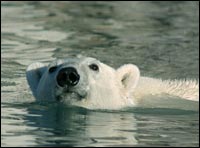While I am in no doubt about the effect of human activity on climate change, I have a friend who is convinced that even if we weren’t destroying the earth, the earth’s own weather patterns would be in global-warming stage anyway. How do we know the current climate change isn’t just an inevitable part of millennia-long weather patterns? Will changing our behavior mean anything if we are all going to burn to a crisp anyway?
Adeline Teoh
Sydney, Australia
Dearest Adeline,
Sorry, no room today to be funny, or to answer the second question. I’ll do both later. For now, get ready for some geology.

God, how I miss the Pleniglacial.
Photo: iStockphoto.
The earth is currently in a warm stage, the Holocene. It’s an interglacial period. The previous interglacial period ended about 130,000 years ago, give or take 20,000 years. Then there was a long glacial period, the Lower Pleniglacial, then a break; then the Late Glacial Cold Stage, which peaked about 21,000 years ago with the Last Glacial Maximum. Everything was much colder and quite arid — the famous giant ice sheet covered large parts of North America, and Australia was all manner of desert and dune.
Even during that time, there were “interstadial” periods of sudden warmth, as well as sudden cold periods. About 14,000 years ago, there were a few millennia of warmth — close to our regular temperatures today — then of course the famous “Younger Dryas,” a massive cold snap, glacial spread, etc., of more than a millennium that affected at least the Northern Hemisphere, ending 11,500 years ago. Then commenced the Holocene.
Whew.
Within the Holocene, there has been variation in global climate. The much-touted ice cores seem to show that the climate has been warmer, then colder, on roughly 1,500-year cycles (at least in the North Atlantic region), with about 2 degrees Celsius defining the difference between the average annual temps in the warm and cold periods. So, yes, there is natural millennial variance in global climate. Climate science does not deny that the climate is variable — and intensely, mind-bogglingly complex. Scientists have taken the available information about the geologic past, the Holocenic past, and the recent past, and created computer models that hope to replicate climatological processes. We’re not talking about dioramas, but incredibly expensive, intricate models that suck up data and digest it for months and months before spewing forth results.
One family of models anticipates the natural millennial cycles of which you speak: assuming no change, if the planet has done x in the past, what will it do next? Another family of models anticipates the results of “anthropogenic forcing.” Again, scientists know from studying the planet since the late 1800s that certain gases are influential in climate processes, and that industrial societies have increased these gases. We are adding, adding, adding, aka “forcing.” There are models that anticipate: if forcing has the impact we educatedly guess it will, what will the climate do next?
The last factor in the puzzle is that we can see what the climate is doing today. For the last century, we’ve put together a good record. We check the two models against What Has Actually Happened. The result is that scientists strongly suspect the current climate change isn’t an inevitable part of millennia-long weather patterns. Here are some charts for confirmation — we love charts this month.
What’s that you say? You want more detail? My 500-word column does not adequately explain interglacial climatic analysis and variance? Do I have some reading for you: the Intergovernmental Panel on Climate Change’s report on the scientific basis of climate change. Skim around! Read the chapters on topics that puzzle you! Arm yourself with factoids that disarm skeptics! And impress your friends and relations!
Holodeckly,
Umbra


